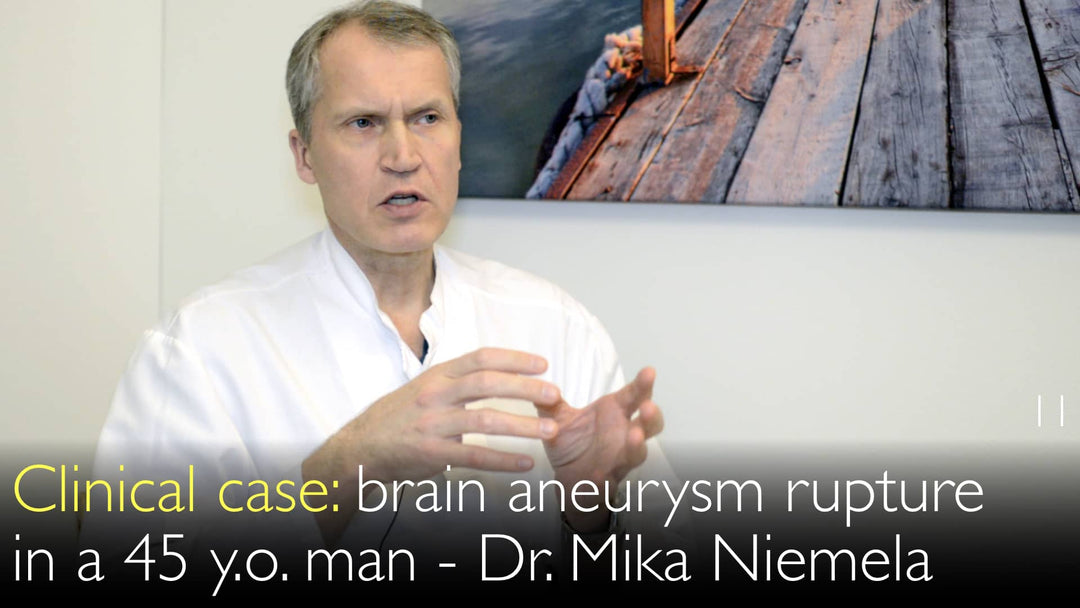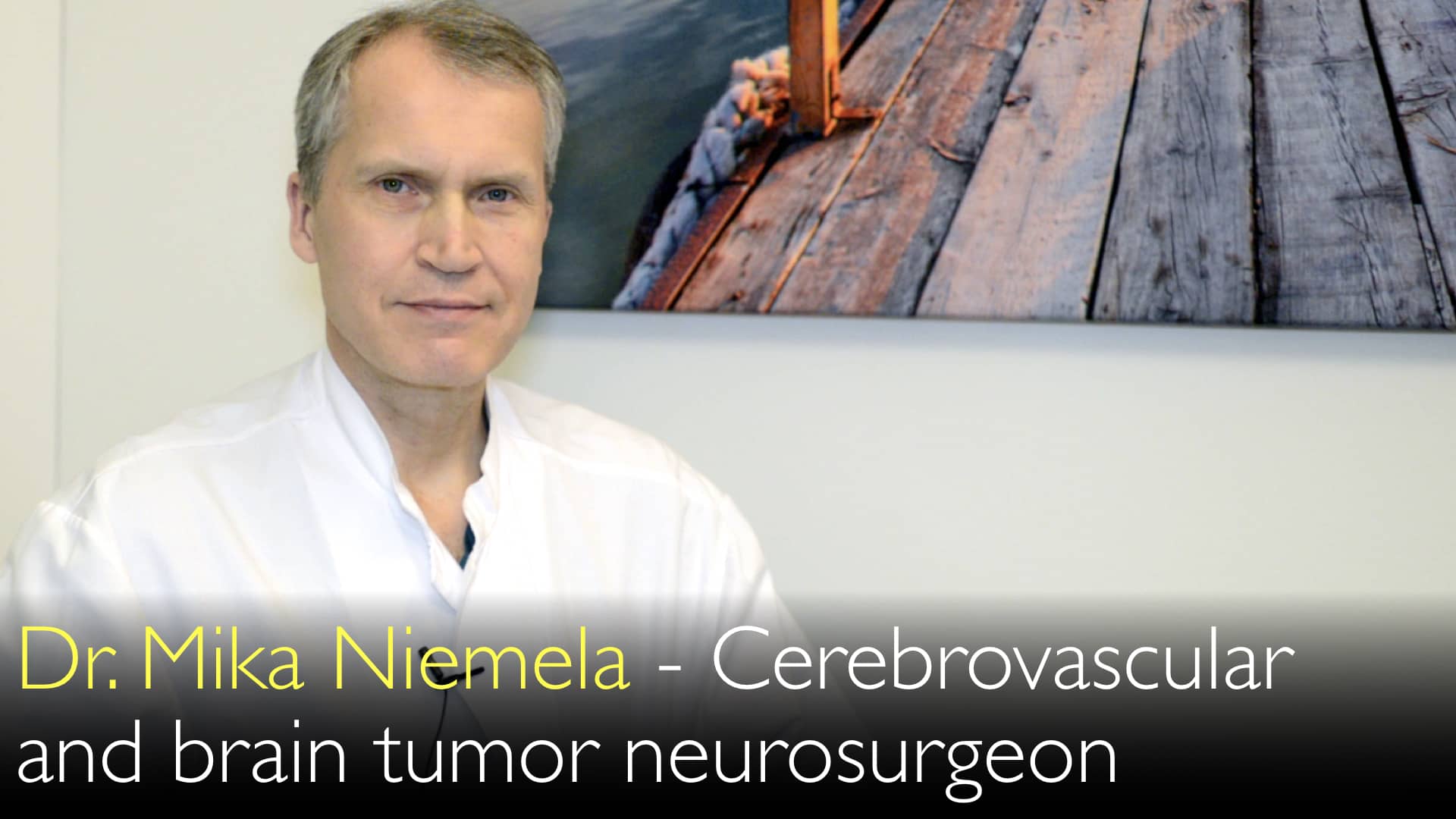Den førende ekspert inden for cerebrovaskulær neurokirurgi, dr. Mika Niemela, forklarer behandlingen af et bristet hjerneaneurisme. Han gennemgår en klinisk sag om en 45-årig mand, der ryger. Behandlingsvalget afhænger af patientens alder samt aneurismets størrelse og placering. Kirurgisk klipping foretrækkes ofte hos yngre patienter med aneurismer i arteria cerebri media. Endovaskulær coiling er et almindeligt alternativ ved andre lokalisationer. Livsstilsændringer som rygestop er afgørende for det langsigtede helbred.
Behandling af ruptureret hjerneaneurisme: Kirurgisk klipping vs. endovaskulær coiling
Spring til afsnit
- Casepræsentation: En 45-årig mand med ruptureret hjerneaneurisme
- Diagnostisk proces ved mistanke om ruptureret hjerneaneurisme
- Behandlingsbeslutning: Faktorer der påvirker valg mellem klipping eller coiling
- Kirurgisk tilgang ved aneurismer i arteria cerebri media
- Endovaskulær alternativ og dets begrænsninger
- Langtidsbehandling og livsstilsændringer efter behandling
- Fuld transskription
Casepræsentation: En 45-årig mand med ruptureret hjerneaneurisme
Dr. Mika Niemela, MD, præsenterer et typisk klinisk tilfælde af en ruptureret hjerneaneurisme. Patienten er en 45-årig mand med tidligere rygning og forhøjet blodtryk. Han oplever et pludseligt kollaps på gaden, hvilket er en almindelig præsentation for subarachnoidalblødning. Denne akutte situation udløser straks en specifik diagnostisk og behandlingsmæssig procedure på hospitalet.
Diagnostisk proces ved mistanke om ruptureret hjerneaneurisme
Det første diagnostiske skridt er en native CT-scanning af hovedet. Denne billeddannende undersøgelse kan afsløre blødning i hjernen, hvilket tyder på en ruptureret aneurisme. Dr. Mika Niemela, MD, forklarer, at hvis lægerne mistænker en aneurisme, gennemgår patienten yderligere vaskulær billeddannelse, typisk en CT-angiografi eller MR-angiografi. Disse avancerede billeddannende teknikker er afgørende for at bekræfte tilstedeværelsen af en aneurisme og kortlægge dens præcise størrelse og placering.
Behandlingsbeslutning: Faktorer der påvirker valg mellem klipping eller coiling
Når en hjerneaneurisme er bekræftet, skal et multidisciplinært team, inklusive neurokirurger, træffe en beslutning om behandling. Dr. Mika Niemela, MD, skitserer de afgørende faktorer i denne beslutning. Patientens alder er en primær overvejelse; en yngre patient har en længere forventet levetid, hvilket gør en holdbar behandling afgørende. Andre nøglefaktorer inkluderer aneurismens størrelse—i dette tilfælde 10 millimeter—og dens specifikke placering inden for hjernens blodkar. Patientens risikofaktorer, som rygning og forhøjet blodtryk, påvirker også den langsigtede prognose og behandlingsstrategi.
Kirurgisk tilgang ved aneurismer i arteria cerebri media
For det præsenterede tilfælde anbefaler Dr. Mika Niemela, MD, kraftigt kirurgisk klipping. Aneurismen er placeret på arteria cerebri media (MCA). Kirurgisk klipping involverer en kraniotomi, hvor en neurokirurg placerer et lille metalclip over aneurismens hals. Dette forhindrer blod i at strømme ind i den og eliminerer effektivt risikoen for reruptur. Denne åbne kirurgiske tilgang er ofte foretrukken for MCA-aneurismer hos yngre, sunde patienter på grund af dens dokumenterede langsigtede holdbarhed.
Endovaskulær alternativ og dets begrænsninger
Endovaskulær coiling er et minimalt invasivt alternativ til åben kirurgi. En kateter føres gennem arterierne til aneurismens placering. Platinspriraler (coils) anbringes derefter i aneurisme sacculen for at fremme koagulering. Dog bemærker Dr. Mika Niemela, MD, en signifikant begrænsning for MCA-aneurismer: en høj risiko for rekanalisering. Rekanalisering betyder, at aneurismen kan genåbne over tid, hvilket nødvendiggør yderligere behandling. Han oplyser, at cirka 50% af alle hjerneaneurismetilfælde i dag behandles med endovaskulære teknikker, men de anvendes hyppigere for aneurismer i hjernens posteriorcirkulation.
Langtidsbehandling og livsstilsændringer efter behandling
Vellykket behandling er kun en del af patientens rejse. Dr. Mika Niemela, MD, understreger vigtigheden af aggressiv risikofaktorbehandling. Ophør med rygning er afgørende for at forbedre den langsigtede vaskulære sundhed. Kontrol af forhøjet blodtryk med medicin er lige så vigtigt. For ældre patienter med meget små aneurismer kan konservativ behandling med risikofaktorkontrol undertiden anbefales fremfor intervention. Dr. Anton Titov, MD, og Dr. Mika Niemela, MD, bekræfter, at patienter efter behandling typisk kan vende tilbage til et normalt liv, inklusive motion, forudsat at de opretholder disse sunde livsstilsændringer.
Fuld transskription
Dr. Anton Titov, MD: En midaldrende mand kollapser på en gade. Ruptureret hjerneaneurisme findes på en CT-scanning. Neurokirurger står over for en beslutning om at udføre åben hjernekirurgi, "klipping" af aneurisme, eller en endovaskulær behandling, "coiling". Hvilken hjerneaneurismebehandlingsmetode ville føre til de bedste resultater?
Er der et klinisk tilfælde, der kunne illustrere de emner, vi diskuterede i dag?
Dr. Mika Niemela, MD: Jeg kan fortælle om nogle hjerneaneurismepatienter. Mange af dem oplever en pludselig aneurismeruptur. Nogen falder måske på gaden.
Lad os sige en 45-årig mand, som er ryger. Rygning forekommer mindre og mindre nu om dage. Men lad os sige, at denne patient er ryger med forhøjet blodtryk. Han falder på gaden. Han bliver bragt til et hospital. Han får en CT-scanning af hovedet.
Lægerne mistænker, at der kan være en ruptureret hjerneaneurisme. Disse patienter henvises til CT-angiografi eller MR-angiografi. En hjerneaneurisme findes. Derefter konsulterer de neurokirurger om patienten.
Der er en 10 millimeter aneurisme i MCA (arteria cerebri media). Skal vi operere eller skal vi behandle denne hjerneaneurisme endovaskulært?
Patienten kommer til en neurokirurgisk afdeling. Vi taler med patienten. Vi overvejer risikofaktorer for hjerneaneurisme. Risikofaktorer er køn, rygestatus, om patienten har forhøjet blodtryk. Måske er der andre tilfælde af ruptureret hjerneaneurisme i familien.
Dr. Anton Titov, MD: Hvad er størrelsen på hjerneaneurismen? I dette tilfælde har en 45-årig mand i Finland næsten 40 års mere forventet levetid.
Dr. Mika Niemela, MD: Denne patient ryger. Så vi beder patienten om at stoppe med at ryge. Normalt anbefaler vi kirurgi ved en 10-millimeter hjerneaneurisme i MCA [arteria cerebri media] i den alder.
Vi foreslår typisk ikke endovaskulær coiling af denne hjerneaneurisme. Fordi der er en høj risiko for rekanalisering ved MCA-aneurismer efter endovaskulær behandling.
Hvis patienten var 75 år gammel, ville vi måske behandle patienten konservativt.
Dr. Anton Titov, MD: Det betyder, at hans forhøjede blodtryk skal behandles godt. Patienter med behandlet hjerneaneurisme kan leve et normalt liv. Vi giver ikke nogen restriktioner. Patienter kan motionere. Men de skal stoppe med at ryge og tage sig af forhøjet blodtryk. Det afhænger af patientens alder.
For en 45-årig patient vælger du kirurgisk behandling af hjerneaneurisme?
Dr. Mika Niemela, MD: Ja. Kirurgisk klipping af hjerneaneurisme i arteria cerebri media. Ja.
Derefter ville du fortsætte med at observere den kliniske situation hos denne patient. Vi følger ældre patienter [vi observerer hjerneaneurisme]. I yngre aldersgrupper afhænger den bedste kliniske handlingsforløb af aneurismens placering.
Vi kan anbefale kirurgi eller endovaskulær hjerneaneurismebehandling. Vi behandler endovaskulært hovedsageligt aneurismer i hjernens posteriorcirkulation.
Vi udfører endovaskulær aneurismecoiling i omkring 50% af alle hjerneaneurismetilfælde i dag.
Dr. Anton Titov, MD: Professor Niemela, mange tak for denne meget interessante samtale!
Dr. Mika Niemela, MD: Det var mig en fornøjelse! Mange tak!
Dr. Anton Titov, MD: Vi ser frem til at se dig igen i fremtiden! Mange tak!





